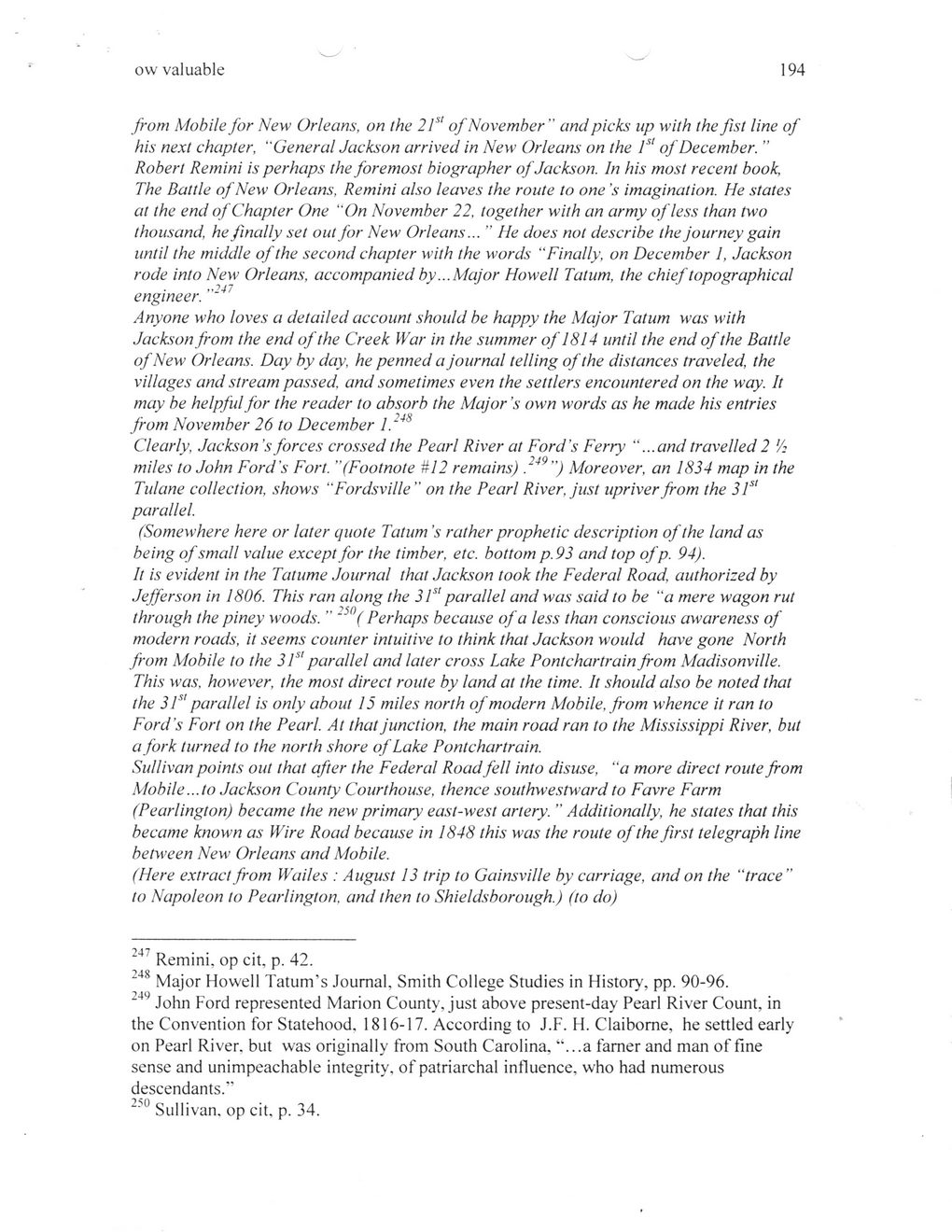This text was obtained via automated optical character recognition.
It has not been edited and may therefore contain several errors.
ow valuable 194 from Mobile for New Orleans, on the 21st of November” and picks up with the fist line of his next chapter, “General Jackson arrived in New Orleans on the lsl of December. ” Robert Remini is perhaps the foremost biographer of Jackson. In his most recent book, The Battle of New Orleans, Remini also leaves the route to one’s imagination. He states at the end of Chapter One “On November 22, together with an army of less than two thousand, he finally set out for New Orleans... ’’ He does not describe the journey gain until the middle of the second chapter with the words “Finally, on December 1, Jackson rode into New Orleans, accompanied by...Major Howell Tatum, the chief topographical engineer. ”247 Anyone who loves a detailed account should be happy the Major Tatum was with Jackson from the end of the Creek War in the summer of 1814 until the end of the Battle of New Orleans. Day by day, he penned a journal telling of the distances traveled, the villages and stream passed, and sometimes even the settlers encountered on the way. It may be helpful for the reader to absorb the Major's own words as he made his entries from November 26 to December 1. Clearly, Jackson’s forces crossed the Pearl River at Ford’s Ferry “...and travelled 2 ‘A miles to John Ford’s Fort. ’’(Footnote #12 remains) 249”) Moreover, an 1834 map in the Tulane collection, shows “Fordsville” on the Pearl River, just upriver from the 31st parallel. (Somewhere here or later quote Tatum’s rather prophetic description of the land as being of small value except for the timber, etc. bottom p.93 and top of p. 94). It is evident in the Tatume Journal that Jackson took the Federal Road, authorized by Jefferson in 1806. This ran along the 31st parallel and was said to be “a mere wagon rut through the piney woods. ’’ 250( Perhaps because of a less than conscious awareness of modern roads, it seems counter intuitive to think that Jackson would have gone North from Mobile to the 31st parallel and later cross Lake Pontchartrain from Madisonville. This was, however, the most direct route by land at the time. It should also be noted that the 31st parallel is only about 15 miles north of modern Mobile, from whence it ran to Ford’s Fort on the Pearl. At that junction, the main road ran to the Mississippi River, but a fork turned to the north shore of Lake Pontchartrain. Sullivan points out that after the Federal Road fell into disuse, “a more direct route from Mobile... to Jackson County Courthouse, thence southwestward to Favre Farm (Pearlington) became the new primary east-west artery. ” Additionally, he states that this became known as Wire Road because in 1848 this was the route of the first telegraph line between New Orleans and Mobile. (Here extract from Wailes : August 13 trip to Gainsville by carriage, and on the “trace” to Napoleon to Pearlington, and then to Shieldsborough.) (to do) 247 Remini, op cit, p. 42. Major Howell Tatum’s Journal, Smith College Studies in History, pp. 90-96. 249 John Ford represented Marion County, just above present-day Pearl River Count, in the Convention for Statehood, 1816-17. According to J.F. H. Claiborne, he settled early on Pearl River, but was originally from South Carolina, “...a famer and man of fine sense and unimpeachable integrity, of patriarchal influence, who had numerous descendants.” 2?0 Sullivan, op cit, p. 34.

Old Spanish Trail Document (059)